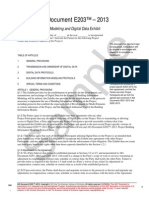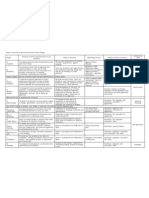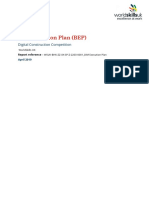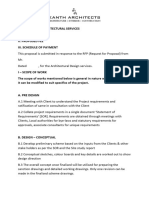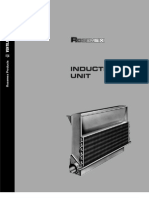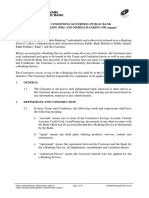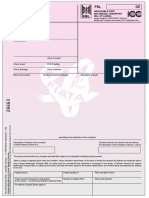RIBA Plan of Work ACU 2
RIBA Plan of Work ACU 2
Uploaded by
Sana SanCopyright:
Available Formats
RIBA Plan of Work ACU 2
RIBA Plan of Work ACU 2
Uploaded by
Sana SanOriginal Description:
Copyright
Available Formats
Share this document
Did you find this document useful?
Is this content inappropriate?
Copyright:
Available Formats
RIBA Plan of Work ACU 2
RIBA Plan of Work ACU 2
Uploaded by
Sana SanCopyright:
Available Formats
1111
RIBA plan of work
RIBA outline plan of work Stage Purpose of work and decisions to be reached To prepare general outline of requirements and plan future action. Tasks to be done People involved All client interests, architect. Commonly used terminology Briefing
A Inception
Set up client organisation for briefing.
B Feasibility
To provide the client with an appraisal and recommendation in order that he may determine the form in which the project is to proceed, ensuring that it is feasible functionally, technically and financially.
Carry out studies of user requirements, site conditions, planning, design, and cost, etc., as necessary to reach decisions
Clients representatives, architects, engineers and QS according to nature of project.
Stage C begins when the architects brief has been determined in sufficient detail. C Outline Proposals To determine general approach to layout, design and construction in order to obtain authoritative approval of the client on the outline proposals and accompanying report. To complete the brief and decide on particular proposals, including planning arrangement appearance, constructional method, outline specification, and cost, and to obtain all approvals. Develop the brief further. Carry out studies on user requirements, technical problems, planning, design and costs, as necessary to reach decisions. Final development brief, full design of the project by architect, preliminary design by engineers, preparation of cost plan and full explanatory report. Submission of proposals for all approvals. All client interests, architects, engineers, QS and specialists are required. Sketch plans
D Scheme Design
All client interests, architects, engineers, QS and specialists and all statutory and other approving authorities.
Brief should not be modified after this point E Detail Design To obtain final decision on every matter related to design, specification, construction and cost. Full design of every part and component of the building by collaboration of all concerned. Complete cost checking of designs. Architects, QS, engineers and specialists, contractor (if appointed). Working drawings
Any further change in location, size, shape, or cost after this time will result in abortive work.
F Production Information
To prepare production information and make final detailed decisions to carry out work.
Preparation of final production information i.e. drawings, schedules and specifications.
Architects, engineers and specialists, contractor (if appointed).
2222
G Bills of Quantities
To prepare and complete all information and arrangements for obtaining tender. Action as recommended in relevant NJCC Code of Procedure for Selective Tendering
Preparation of Bills of Quantities and tender documents.
Architects, QS, engineers, contractor, client. Architects, QS, engineers, contractor, client.
H Tender Action
Action as recommended in relevant NJCC Code of Procedure for Selective Tendering
J Project Planning
To enable the contractor to programme the work in accordance with contract conditions; brief site inspectorate; and make arrangements to commence work on site. To follow plans through to practical completion of the building.
Action in accordance with RIBA Plan of Work
Contractor, subcontractors.
Site operations
K Operations on Site
Action in accordance with RIBA Plan of Work.
Architects, engineers, contractors, sub-contractors, QS, client. Architects, engineers, contractor, QS, client.
L Completion
To hand over the building to the client for occupation, remedy any defects, settle the final account, and complete all work in accordance with the contract.
Action in accordance with RIBA Plan of Work
M Feedback
To analyse the management, construction and performance of the project.
Analysis of job records. Inspections of completed building. Studies of building in use.
Architect, engineers, QS, contractor, client.
The Outline Plan of Work as included in: Architects Handbook of Practice Management (RIBA Publications 1991)
3333
PROCESS: PROJECT PLAN
Key: Stage
1. Purpose of work and Decisions to be reached 2. Tasks to be done 3. People directly involved
A. Inception (Briefing)
1. To prepare general outline of requirements and plan future action. 2. Set up client organization for briefing. Consider requirements, appoint architect. 3. All client interests, architect.
B. Feasibility
1. To provide the client with an appraisal and recommendation in order that he may determine the form in which the project is to proceed, ensuring that it is feasible, functionally, technically and financially. 2. Carry out studies of user requirements, site conditions, planning, design, and cost, etc., as necessary to reach decisions. 3. Clients representatives, architects, engineers, and as according to nature of project.
C. Outline Proposals (Sketch Plans)
1. To determine general approach to layout, design and construction in order to obtain authoritative approval of the client on the outline proposals and accompanying report. 2. Develop the brief further. Carry out studies on user requirements, technical problems, planning, design and costs, as necessary to reach decisions. 3. All client interests, architects, engineers, and specialists as required.
D. Scheme Design
1. To complete the brief and decide on particular proposals, including planning arrangement appearance, constructional method. outline specification. and cots, and to obtain all approvals. 2. Final development of the brief, full design of the project by architect, preliminary design by engineers, preparation of cost plan and full explanatory report. Submission of proposals for all approvals. 3. All client interests, architects, engineers, QS and specialists and all Statutory and other approving authorities. Brief should not be modified after this point.
E. Detail Design (Working Drawings)
1. To obtain final decision on every matter related to design, Specification, construction and cost. 2. Full design of every part and component of the building by collaboration of all concerned. Complete coat checking of designs. 3. Architects, engineers and specialists, contractor (if appointed). Any further change in location. size, shape, or cost after this time will result in abortive work.
4444
F. Production Information
1. To prepare production information and make final detailed decisions to carry out work. 2. Preparation of final production information i.e. drawings, schedules and specifications. 3. Architects, engineers and specialists, contractor (if Appointed).
G. Bill of Quantities
1. To prepare and complete all information and arrangements for obtaining tender. 2. Preparation of Bills of quantities and tender documents. 3. Architects, contractor (if appointed).
H. Tender Action
1. Action as recommended in NJCC Code of Procedure for Single Stage Selective Tendering 1977,. 2. Action as recommended in NJCC Code of Procedure for Single Stage Selective Tendering 1977,. 3. Architects, engineers, contractor, Client.
J. Project Planning
1. To enable the contractor to programme the work in accordance with contract conditions; brief Site inspectorate; and make arrangements to commence work on Site. 2. Action in accordance with The Management of Building Contracts and Diagram 9. 3. Contractor, sub-contractors.
K. Operations on Site
1. To follow plans through to practical completion of the building. 2. Action in accordance with The Management of Building Contracts and Diagram 10. 3. Architects, engineers, contractors. subcontractors, client.
L. Completion
1. To hand over the building to the client for occupation. remedy any defects, Settle the final account and complete all work is accordance with the contract 2. Action in accordance with The Management of Building Contracts and Diagram 11. 3. Architects, engineers, contractor, client.
M. Feed-Back
1. To analyse the management, construction and performance of the project. 2. Analysis of job records. Inspection of completed building Studies of building in use. 3. Architect, engineers, contractor, client.
5555
The RIBA Plan of Work Stages
The RIBA Plan of Work is a robust process protocol which describes the activities from appraising the requirements through to post construction The stages are also used in the appointing documents to he architects services.
A: Appraisal
Identification of Client's requirements and possible constraints on development. Preparation of studies to enable the Client to decide whether to proceed and to select probable procur
B: Strategic Briefing
Preparation of Strategic Brief by, or on behalf of, the client confirming key requirements and constraint of procedures, organisational structure and range of consultants and others to be engaged for the proj the strategic brief (as CIB Guide) which becomes the clear responsibility of the client]
C: Outline proposals.
Commence development of strategic brief into full project brief. Preparation of outline proposals and estimate of cost. Review of procurement route.
D: Detailed proposals.
Complete development of the project brief. Preparation of detailed proposals. Application for full development control approval.
E: Final proposals.
Preparation of final proposals for the Project sufficient for co-ordination of all components and element
F: Production information
F1: Preparation of production information in sufficient detail to enable a tender or tenders to be obtaine Application for statutory approvals. F2: Preparation of further production information required under the building contract. [Now in two part production information sufficient to obtain tenders and F2 - the balance required under the building con complete the information for construction]
G: Tender documentation.
Preparation and collation of tender documentation in sufficient detail to enable a tender or tenders to b the construction of the Project. [Solely concerned with the documentation required for tenders. Particu D+B or management contracts]
H: Tender action.
Identification and evaluation of potential contractors and/or specialists for the construction of the projec and appraising tenders and submission of recommendations to the client.
J: Mobilisation.
Letting the building contract, appointing the contractor. Issuing of production information to the contractor. Arranging site handover to the contractor.
K: Construction to Practical Completion.
Administration of the building contract up to and including practical completion. Provision to the contractor of further information as and when reasonably required.
L: After Practical completion.
Administration of the building contract after practical completion. Making final inspections and settling the final account. [Clearly separated from the construction phase ]
6666
OUTLINE PLAN OF WORK
A: Appraisal
Carry out studies to determine the feasibility of the Client's requirements. Review with the Client alternative design and construction approaches and the cost implications
B: Strategic Briefing
Preparation of a Strategic Brief, on behalf of the client, confirming key requirements and constraints. Identification of procedures, organisational structure and range of consultants and others to be engaged for the Project.
C: Outline Proposals
Prepare Outline Proposals Provide information for cost planning Produce communication drawings for use with, Planning Authority, Neighbour, and Freeholders Report on environmental and energy efficiency opportunities Submit to Client outline proposals and approximate construction cost
D: Detailed Proposals
Develop the Detailed Proposals from approved Outline Proposals Provide information for preparations of cost estimate Consult statutory authorities Incorporate environmental and energy efficiency strategy. Submit to Client the Detailed Proposals, showing spatial arrangements, materials and appearance, and a cost estimate Prepare and submit application for full planning permission
E: Final Proposals
Develop Final Proposals from approved Detailed Proposals Provide information for revision of cost estimate Consult statutory authorities on developed design proposals Submit to Client type of construction, quality of materials, standard of workmanship and revised cost estimate Advise on consequences of any subsequent changes on cost and programme
F: Production Information
Prepare production information for tender purposes Prepare schedules of rates and / or schedules of works for tendering purposes and revise cost estimate Provide information for preparation of tender pricing documents and revision of cost estimate Prepare and make submissions under building acts and / or regulations or other statutory requirements Prepare further production information for construction purposes
G: Tender Documentation
Prepare and collate tender documents in sufficient detail to enable a tender or tenders to be obtained Where applicable pass final information to Planning Supervisor for pre-tender Health and Safety Plan Provide information for preparations of pretender cost estimate
H: Tender Action
Contribute to appraisal and report on tenders / negotiations
J: Mobilisation
Provide production information as required for the building contract and for construction
7777
K: Construction to Practical Completion
Make Visits to the Works in connection with the Architect's design Provide further information reasonably required for construction Review design information from contractors or specialists Provide drawings showing the building and main lines of drainage and other information for the Health and Safety File Give general advice on operation and maintenance of the building
L: After Practical Completion
Identify defects and make final inspections Settle Final Account, or, provide information required by others for settling final account
You might also like
- Final Caa2019Document17 pagesFinal Caa2019shreyaashah1992No ratings yet
- Riba Guide Urm April 2015Document4 pagesRiba Guide Urm April 2015TunENSTABNo ratings yet
- RIBA ProjecRIBA Project Quality Plan For Small Projectst Quality Plan For Small ProjectsDocument39 pagesRIBA ProjecRIBA Project Quality Plan For Small Projectst Quality Plan For Small Projectsseaforte03100% (1)
- Scope ChecklistDocument1 pageScope ChecklistKhayCeeMuñozNo ratings yet
- Riba Arb ComparedDocument6 pagesRiba Arb ComparedAsha BiantNo ratings yet
- RIBA Plan of Work 2020 - Toolbox v1.3: WHO Is in The Project Team?Document88 pagesRIBA Plan of Work 2020 - Toolbox v1.3: WHO Is in The Project Team?Debasish Dey0% (1)
- Quote & Invoice For STR & BIMDocument3 pagesQuote & Invoice For STR & BIMShergul KhanNo ratings yet
- The Royal Institute of British Architects (RIBA) Plan of Work StagesDocument5 pagesThe Royal Institute of British Architects (RIBA) Plan of Work StagesRobNo ratings yet
- RIBA Work StagesDocument4 pagesRIBA Work StagesMuzzammil AyobNo ratings yet
- Arch 7182 - Lecture WK 6 - Client Architect Agreements Part 3Document40 pagesArch 7182 - Lecture WK 6 - Client Architect Agreements Part 3Ben ShenNo ratings yet
- Architect CA Instruction ConciseDocument1 pageArchitect CA Instruction ConciseDen OghangsombanNo ratings yet
- Kca Fee ProposalDocument2 pagesKca Fee Proposalmartinburns100% (3)
- AIA Document E203™-2013Document7 pagesAIA Document E203™-2013Sohaib Ahmed100% (2)
- Leave MemoDocument2 pagesLeave MemoJanking Madriaga I33% (3)
- Case Concerning Rights of Nationals of The USA in Morocco DigestDocument2 pagesCase Concerning Rights of Nationals of The USA in Morocco DigestSecret SecretNo ratings yet
- The Age Discrimination Act of 1975Document15 pagesThe Age Discrimination Act of 1975Sam UdumaNo ratings yet
- RIBA WorkstagesDocument1 pageRIBA WorkstagesCong TranNo ratings yet
- Riba Outline Plan of WorkDocument3 pagesRiba Outline Plan of Workmarston22No ratings yet
- Riba OutlineDocument3 pagesRiba OutlineYakoob Arshad KamilNo ratings yet
- Brief Should Not Be Modified After This PointDocument2 pagesBrief Should Not Be Modified After This PointHeshan Raween de SilvaNo ratings yet
- Stage 0 ChecklistDocument12 pagesStage 0 ChecklistJoel BautistaNo ratings yet
- RIBA Plan of Work Toolbox v1 - 1Document90 pagesRIBA Plan of Work Toolbox v1 - 1Valentina PelaezNo ratings yet
- RibaDocument1 pageRibaMohamed KhalidNo ratings yet
- BIM Key ContractualDocument4 pagesBIM Key ContractualZharel AhmadNo ratings yet
- Stages of Work: Himanshu Negi Dit University VTH YrDocument5 pagesStages of Work: Himanshu Negi Dit University VTH YrSrishti SharmaNo ratings yet
- RIBA Plan of Work GuidanceDocument121 pagesRIBA Plan of Work Guidancedoug2710100% (1)
- 4 Technical Design Checklist PDFDocument14 pages4 Technical Design Checklist PDFravNo ratings yet
- Riba ReportDocument25 pagesRiba ReportAbdullah AhmedNo ratings yet
- BIM Overlay RIBA Plan of WorkDocument2 pagesBIM Overlay RIBA Plan of WorkOlumide OkuneyeNo ratings yet
- Design MethodologyDocument3 pagesDesign MethodologyybrahimjNo ratings yet
- Architects Scale of Minimun FeesDocument23 pagesArchitects Scale of Minimun FeesNek ManNo ratings yet
- Appendix 10 RIBA Schedule of Multidisciplinary ServicesDocument50 pagesAppendix 10 RIBA Schedule of Multidisciplinary ServicescsharpplusNo ratings yet
- CAA-2009 ReferenceDocument16 pagesCAA-2009 ReferenceenggmohanNo ratings yet
- Pre-Tender Review: Infrastructure Finance, and Capital Works (IFCW) Quality Checklist Buiding Projects Pre-Tender ReviewDocument16 pagesPre-Tender Review: Infrastructure Finance, and Capital Works (IFCW) Quality Checklist Buiding Projects Pre-Tender ReviewUsman Shahid100% (1)
- Architectural ServicesDocument3 pagesArchitectural ServicesAnna AmirianNo ratings yet
- Architectural ProposalDocument7 pagesArchitectural ProposallakhanNo ratings yet
- Plan of Work For Residential Projects: The Project BriefDocument4 pagesPlan of Work For Residential Projects: The Project BriefbogdaniplNo ratings yet
- RIBA Plan of Work 2013 - PresentationDocument68 pagesRIBA Plan of Work 2013 - Presentationelchuno100% (3)
- Riba Quality Management ToolkitDocument8 pagesRiba Quality Management Toolkitselinasimpson2301No ratings yet
- Architect - Professional Fees - Architecture Ideas PDFDocument7 pagesArchitect - Professional Fees - Architecture Ideas PDFyesha parekhNo ratings yet
- Digital Construction Execution PlanDocument24 pagesDigital Construction Execution PlanCarolina DiazNo ratings yet
- Lindenwood Residences Proposal (Ambf X No of Storeys)Document8 pagesLindenwood Residences Proposal (Ambf X No of Storeys)Ponz MadianoNo ratings yet
- Architect S AppointmentDocument39 pagesArchitect S AppointmentChokKohSiong100% (1)
- 7 Use ChecklistDocument6 pages7 Use ChecklistyeyosanchezNo ratings yet
- The Shift To Digital Construction Ebook FinalDocument15 pagesThe Shift To Digital Construction Ebook FinalcristicomanNo ratings yet
- M1. Architectural Design Process and MethodologiesDocument7 pagesM1. Architectural Design Process and MethodologiesKentNo ratings yet
- Stage 4 - Technical Design ChecklistDocument23 pagesStage 4 - Technical Design ChecklistVirah Sammy ChandraNo ratings yet
- L.Atelier Architects: The 8-Step Design MethodologyDocument14 pagesL.Atelier Architects: The 8-Step Design MethodologyLara Therese Diaz CruzNo ratings yet
- RIBADocument40 pagesRIBANeia SouzaNo ratings yet
- Aia Style GuideDocument10 pagesAia Style GuideJaytee100% (1)
- RIBA-2020-plan of Work StageDocument1 pageRIBA-2020-plan of Work Stagesteven ZhaoNo ratings yet
- Proposal For Architectural ServicesDocument7 pagesProposal For Architectural ServicesCrissa De VeraNo ratings yet
- Standard of Architectural Services and Scale of ChargesDocument10 pagesStandard of Architectural Services and Scale of ChargesamlaNo ratings yet
- Tender B - Architectural SpecficationsDocument188 pagesTender B - Architectural SpecficationsJe M'appelle NofreNo ratings yet
- Architectural Scope of ServicesDocument5 pagesArchitectural Scope of ServicesCamille MacatangayNo ratings yet
- Elemental Cost Format For Building Conservation Works in MalaysiaDocument12 pagesElemental Cost Format For Building Conservation Works in MalaysiaZulhelmi Sabri100% (1)
- BIM Project Execution Planning Guide Version 3.0 1619002597Document143 pagesBIM Project Execution Planning Guide Version 3.0 1619002597Lizbeth Gamboa ChamboNo ratings yet
- Agreement ContractDocument5 pagesAgreement ContractB-05 ISHA PATELNo ratings yet
- SchedulesDocument30 pagesSchedulesmalshan100No ratings yet
- KANTH ARCHITECTS PROPOSAL FOR ARCHITECTURAL SERVICES 1Document4 pagesKANTH ARCHITECTS PROPOSAL FOR ARCHITECTURAL SERVICES 1architectkanth.kNo ratings yet
- BSC Payment PLanDocument1 pageBSC Payment PLanSana SanNo ratings yet
- Pre Contract Cost Planning by Lahiru Dananjaya ADocument19 pagesPre Contract Cost Planning by Lahiru Dananjaya AKumari Wasala100% (1)
- Value Engineerin Management TechDocument6 pagesValue Engineerin Management TechSana SanNo ratings yet
- All Handbag Lovers ...Document7 pagesAll Handbag Lovers ...Sana SanNo ratings yet
- Environmental PoliciesDocument8 pagesEnvironmental PoliciesSana SanNo ratings yet
- Environmental PoliciesDocument8 pagesEnvironmental PoliciesSana SanNo ratings yet
- Ind UnitDocument33 pagesInd UnitSana SanNo ratings yet
- Terms & Conditions Governing Public Bank Online Banking (Pbe) and Mobile Banking (PB Engage) NoticeDocument27 pagesTerms & Conditions Governing Public Bank Online Banking (Pbe) and Mobile Banking (PB Engage) NoticeDmseroja 7982No ratings yet
- Securitization and The Credit Crisis of 2007: Practice QuestionsDocument5 pagesSecuritization and The Credit Crisis of 2007: Practice QuestionsVishal GoyalNo ratings yet
- Fiata Front B-LDocument1 pageFiata Front B-LPhạm Bùi Bảo TuấnNo ratings yet
- Maximum Social Advantage in Details PDFDocument18 pagesMaximum Social Advantage in Details PDFDombrudhor TantiNo ratings yet
- AK-Sen Harstad Research For Senate Majority PACDocument2 pagesAK-Sen Harstad Research For Senate Majority PACDaily Kos ElectionsNo ratings yet
- Friendship: An Augustinian ValueDocument28 pagesFriendship: An Augustinian ValueKewl-la-laNo ratings yet
- The Correspondence and Public Papers of John Jay, Vol. III (1782-1793)Document515 pagesThe Correspondence and Public Papers of John Jay, Vol. III (1782-1793)Robert ValeNo ratings yet
- Mayar (H.K.) Ltd. & Ors Vs Owners & Parties, Vessel M.V. ... On 30 January, 2006Document18 pagesMayar (H.K.) Ltd. & Ors Vs Owners & Parties, Vessel M.V. ... On 30 January, 2006Mayank MishraNo ratings yet
- NBM No129 PDFDocument82 pagesNBM No129 PDFRich Sheena Mae PascuaNo ratings yet
- New Adhar Consent FormDocument1 pageNew Adhar Consent Formsourav84No ratings yet
- MBS FormDocument1 pageMBS Formcmog adjutantNo ratings yet
- Tax Preparer ResumeDocument8 pagesTax Preparer Resumec2q5bm7q100% (1)
- Why Ethics Matter CHAPTER 1 NOTESDocument3 pagesWhy Ethics Matter CHAPTER 1 NOTESAdil ArshadNo ratings yet
- The Drugs (Control) Act, 1950Document3 pagesThe Drugs (Control) Act, 1950Leo Lukose100% (2)
- Hardware Setup Manual: Edius NX Pci-X / Edius NX Pci-E / Edius NX Express / HdstormDocument52 pagesHardware Setup Manual: Edius NX Pci-X / Edius NX Pci-E / Edius NX Express / HdstormDaniel SevillaNo ratings yet
- Triste V Leyte State CollegeDocument2 pagesTriste V Leyte State CollegeOwen Buenaventura100% (3)
- Brief Summary AP Solar + Storage 1MWDocument4 pagesBrief Summary AP Solar + Storage 1MWManohar PotnuruNo ratings yet
- Queen VictoriaDocument4 pagesQueen VictoriaNaomi0% (1)
- Rules - and - Regulations - Implementing - Republic - Act - 10175-17 (13 Files Merged)Document16 pagesRules - and - Regulations - Implementing - Republic - Act - 10175-17 (13 Files Merged)ban diazNo ratings yet
- Lee Kuan YewDocument63 pagesLee Kuan YewRadovan Spiridonov100% (1)
- Human Resources Management in Public and Nonprofit Organizations (3rd Edition)Document10 pagesHuman Resources Management in Public and Nonprofit Organizations (3rd Edition)mustamuNo ratings yet
- Lesson 2.a EVOLUTION OF POLICINGDocument4 pagesLesson 2.a EVOLUTION OF POLICINGGesler Pilvan Sain100% (1)
- Test ManitowocDocument9 pagesTest ManitowocMANUEL CASTILLONo ratings yet
- ProverbsDocument352 pagesProverbsprekapal100% (3)
- Common Ancestor of 5 US PresidentsDocument3 pagesCommon Ancestor of 5 US PresidentsLloyd TaylorNo ratings yet
- Eticket 73186093Document2 pagesEticket 73186093AAYUSH SARKARNo ratings yet
- Juan de Plasencia, O.F.MDocument51 pagesJuan de Plasencia, O.F.MKaia LouisNo ratings yet












